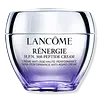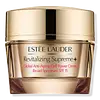What's inside
What's inside
 Key Ingredients
Key Ingredients

 Benefits
Benefits

 Concerns
Concerns

 Ingredients Side-by-side
Ingredients Side-by-side

Water
Skin ConditioningGlycerin
HumectantDimethicone
EmollientCetearyl Alcohol
EmollientTheobroma Grandiflorum Seed Butter
Skin ConditioningAlcohol Denat.
AntimicrobialCetearyl Isononanoate
EmollientNiacinamide
SmoothingGlyceryl Stearate
EmollientPEG-100 Stearate
Isopropyl Palmitate
EmollientOctyldodecanol
EmollientCyclodextrin
AbsorbentHydrolyzed Lupine Protein
Skin ConditioningPisum Sativum Extract
Skin ConditioningAdenosine
Skin ConditioningCapryloyl Salicylic Acid
ExfoliatingHydrolyzed Hyaluronic Acid
HumectantHydrolyzed Linseed Extract
Skin ConditioningPentaerythrityl Tetra-Di-T-Butyl Hydroxyhydrocinnamate
AntioxidantTrisodium Ethylenediamine Disuccinate
Tocopheryl Acetate
AntioxidantCera Alba
EmollientOrbignya Oleifera Seed Oil
EmollientSimmondsia Chinensis Butter
Skin ConditioningCetearyl Glucoside
EmulsifyingCitric Acid
BufferingHydroxyethyl Acrylate/Sodium Acryloyldimethyl Taurate Copolymer
Emulsion StabilisingPolysorbate 60
EmulsifyingPotassium Cetyl Phosphate
EmulsifyingSorbitan Isostearate
EmulsifyingTocopherol
AntioxidantDimethicone/Polyglycerin-3 Crosspolymer
CleansingBenzyl Alcohol
PerfumingGeraniol
PerfumingLimonene
PerfumingChlorphenesin
AntimicrobialDipropylene Glycol
HumectantPhenoxyethanol
PreservativeSodium Benzoate
MaskingParfum
MaskingWater, Glycerin, Dimethicone, Cetearyl Alcohol, Theobroma Grandiflorum Seed Butter, Alcohol Denat., Cetearyl Isononanoate, Niacinamide, Glyceryl Stearate, PEG-100 Stearate, Isopropyl Palmitate, Octyldodecanol, Cyclodextrin, Hydrolyzed Lupine Protein, Pisum Sativum Extract, Adenosine, Capryloyl Salicylic Acid, Hydrolyzed Hyaluronic Acid, Hydrolyzed Linseed Extract, Pentaerythrityl Tetra-Di-T-Butyl Hydroxyhydrocinnamate, Trisodium Ethylenediamine Disuccinate, Tocopheryl Acetate, Cera Alba, Orbignya Oleifera Seed Oil, Simmondsia Chinensis Butter, Cetearyl Glucoside, Citric Acid, Hydroxyethyl Acrylate/Sodium Acryloyldimethyl Taurate Copolymer, Polysorbate 60, Potassium Cetyl Phosphate, Sorbitan Isostearate, Tocopherol, Dimethicone/Polyglycerin-3 Crosspolymer, Benzyl Alcohol, Geraniol, Limonene, Chlorphenesin, Dipropylene Glycol, Phenoxyethanol, Sodium Benzoate, Parfum
Water
Skin ConditioningOctocrylene
UV AbsorberButyloctyl Salicylate
Skin ConditioningEthylhexyl Salicylate
UV AbsorberGlycerin
HumectantButyl Methoxydibenzoylmethane
UV AbsorberPolysorbate 60
EmulsifyingCetyl Alcohol
EmollientSorbitan Stearate
EmulsifyingDimethicone
EmollientTridecyl Stearate
EmollientButylene Glycol
HumectantPentylene Glycol
Skin ConditioningMoringa Oleifera Seed Extract
Skin ConditioningTuna Extract
Skin ConditioningHordeum Vulgare Extract
EmollientCucumis Sativus Fruit Extract
EmollientNarcissus Tazetta Bulb Extract
AstringentSigesbeckia Orientalis Extract
Skin ConditioningPyrus Malus Fruit Extract
Skin ConditioningLens Esculenta Fruit Extract
Skin ConditioningLactis Proteinum
Skin ConditioningCitrus Medica Vulgaris Fruit Extract
AntioxidantCaffeine
Skin ConditioningAlgae Extract
EmollientLaminaria Digitata Extract
Skin ProtectingTocopheryl Acetate
AntioxidantAcetyl Glucosamine
Skin ConditioningAstrocaryum Murumuru Seed Butter
EmollientSucrose
HumectantTridecyl Trimellitate
EmollientDipentaerythrityl Hexacaprylate/Hexacaprate
EmulsifyingPEG-100 Stearate
Trehalose
HumectantCetyl Palmitate
EmollientSorbitol
HumectantAcetyl Hexapeptide-8
HumectantSodium Lactate
BufferingAcrylates/C10-30 Alkyl Acrylate Crosspolymer
Emulsion StabilisingSodium Benzoate
MaskingSorbitan Palmitate
EmulsifyingSorbitan Olivate
EmulsifyingEthylhexylglycerin
Skin ConditioningSodium PCA
HumectantPvp
Emulsion StabilisingSodium Polyacrylate
AbsorbentPropylene Glycol Dicaprate
EmollientSodium Hyaluronate
HumectantIsoceteth-20
EmulsifyingHelianthus Annuus Seedcake
AbrasivePolyethylene
AbrasiveParfum
MaskingTetrahexyldecyl Ascorbate
AntioxidantSodium Hydroxide
BufferingDisodium EDTA
BHT
AntioxidantPhenoxyethanol
PreservativeChlorphenesin
AntimicrobialCI 19140
Cosmetic ColorantCI 14700
Cosmetic ColorantWater, Octocrylene, Butyloctyl Salicylate, Ethylhexyl Salicylate, Glycerin, Butyl Methoxydibenzoylmethane, Polysorbate 60, Cetyl Alcohol, Sorbitan Stearate, Dimethicone, Tridecyl Stearate, Butylene Glycol, Pentylene Glycol, Moringa Oleifera Seed Extract, Tuna Extract, Hordeum Vulgare Extract, Cucumis Sativus Fruit Extract, Narcissus Tazetta Bulb Extract, Sigesbeckia Orientalis Extract, Pyrus Malus Fruit Extract, Lens Esculenta Fruit Extract, Lactis Proteinum, Citrus Medica Vulgaris Fruit Extract, Caffeine, Algae Extract, Laminaria Digitata Extract, Tocopheryl Acetate, Acetyl Glucosamine, Astrocaryum Murumuru Seed Butter, Sucrose, Tridecyl Trimellitate, Dipentaerythrityl Hexacaprylate/Hexacaprate, PEG-100 Stearate, Trehalose, Cetyl Palmitate, Sorbitol, Acetyl Hexapeptide-8, Sodium Lactate, Acrylates/C10-30 Alkyl Acrylate Crosspolymer, Sodium Benzoate, Sorbitan Palmitate, Sorbitan Olivate, Ethylhexylglycerin, Sodium PCA, Pvp, Sodium Polyacrylate, Propylene Glycol Dicaprate, Sodium Hyaluronate, Isoceteth-20, Helianthus Annuus Seedcake, Polyethylene, Parfum, Tetrahexyldecyl Ascorbate, Sodium Hydroxide, Disodium EDTA, BHT, Phenoxyethanol, Chlorphenesin, CI 19140, CI 14700
 Reviews
Reviews

Ingredients Explained
These ingredients are found in both products.
Ingredients higher up in an ingredient list are typically present in a larger amount.
Chlorphenesin is a synthetic preservative. It helps protect a product against bacteria in order to extend shelf life. In most cases, Chlorphenesin is paired with other preservatives such as phenoxyethanol and caprylyl glycol.
Chlorphenesin is a biocide. This means it is able to help fight the microorganisms on our skin. It is also able to fight odor-releasing bacteria.
Chlorphenesin is soluble in both water and glycerin.
Studies show Chlorphenesin is easily absorbed by our skin. You should speak with a skincare professional if you have concerns about using Chlorphenesin.
Learn more about ChlorphenesinDimethicone is a type of synthetic silicone created from natural materials such as quartz.
What it does:
Dimethicone comes in different viscosities:
Depending on the viscosity, dimethicone has different properties.
Ingredients lists don't always show which type is used, so we recommend reaching out to the brand if you have questions about the viscosity.
This ingredient is unlikely to cause irritation because it does not get absorbed into skin. However, people with silicone allergies should be careful about using this ingredient.
Note: Dimethicone may contribute to pilling. This is because it is not oil or water soluble, so pilling may occur when layered with products. When mixed with heavy oils in a formula, the outcome is also quite greasy.
Learn more about DimethiconeGlycerin is already naturally found in your skin. It helps moisturize and protect your skin.
A study from 2016 found glycerin to be more effective as a humectant than AHAs and hyaluronic acid.
As a humectant, it helps the skin stay hydrated by pulling moisture to your skin. The low molecular weight of glycerin allows it to pull moisture into the deeper layers of your skin.
Hydrated skin improves your skin barrier; Your skin barrier helps protect against irritants and bacteria.
Glycerin has also been found to have antimicrobial and antiviral properties. Due to these properties, glycerin is often used in wound and burn treatments.
In cosmetics, glycerin is usually derived from plants such as soybean or palm. However, it can also be sourced from animals, such as tallow or animal fat.
This ingredient is organic, colorless, odorless, and non-toxic.
Glycerin is the name for this ingredient in American English. British English uses Glycerol/Glycerine.
Learn more about GlycerinParfum is a catch-all term for an ingredient or more that is used to give a scent to products.
Also called "fragrance", this ingredient can be a blend of hundreds of chemicals or plant oils. This means every product with "fragrance" or "parfum" in the ingredients list is a different mixture.
For instance, Habanolide is a proprietary trade name for a specific aroma chemical. When used as a fragrance ingredient in cosmetics, most aroma chemicals fall under the broad labeling category of “FRAGRANCE” or “PARFUM” according to EU and US regulations.
The term 'parfum' or 'fragrance' is not regulated in many countries. In many cases, it is up to the brand to define this term.
For instance, many brands choose to label themselves as "fragrance-free" because they are not using synthetic fragrances. However, their products may still contain ingredients such as essential oils that are considered a fragrance by INCI standards.
One example is Calendula flower extract. Calendula is an essential oil that still imparts a scent or 'fragrance'.
Depending on the blend, the ingredients in the mixture can cause allergies and sensitivities on the skin. Some ingredients that are known EU allergens include linalool and citronellol.
Parfum can also be used to mask or cover an unpleasant scent.
The bottom line is: not all fragrances/parfum/ingredients are created equally. If you are worried about fragrances, we recommend taking a closer look at an ingredient. And of course, we always recommend speaking with a professional.
Learn more about ParfumPeg-100 Stearate is an emollient and emulsifier. As an emollient, it helps keep skin soft by trapping moisture in. On the other hand, emulsifiers help prevent oil and water from separating in a product.
PEGS are a hydrophilic polyether compound . There are 100 ethylene oxide monomers in Peg-100 Stearate. Peg-100 Stearate is polyethylene glycol ester of stearic acid.
Phenoxyethanol is a preservative that has germicide, antimicrobial, and aromatic properties. Studies show that phenoxyethanol can prevent microbial growth. By itself, it has a scent that is similar to that of a rose.
It's often used in formulations along with Caprylyl Glycol to preserve the shelf life of products.
Polysorbate 60 is used to help stabilize products. It is a surfactant and emulsifier. These properties help keep ingredients together in a product. Surfactants help reduce surface tension between ingredients with different states, such as liquids and solids. Emulsifiers help prevent oils and waters from separating.
Polysorbate 60 is sorbitol-based and created from the ethoxylation of sorbitan. Ethoxylation is a chemical reaction used to add ethylene oxide. Sorbitan is a the dehydrated version of sorbitol, a sugar found in fruits.
In this case, the 60 comes from reacting 60 units of ethylene oxide with sorbitan.
Polysorbates are commonly used in medicine and foods.
Learn more about Polysorbate 60Sodium Benzoate is a preservative. It's used in both cosmetic and food products to inhibit the growth of mold and bacteria. It is typically produced synthetically.
Both the US FDA and EU Health Committee have approved the use of sodium benzoate. In the US, levels of 0.1% (of the total product) are allowed.
Sodium benzoate works as a preservative by inhibiting the growth of bacteria inside of cells. It prevents the cell from fermenting a type of sugar using an enzyme called phosphofructokinase.
It is the salt of benzoic acid. Foods containing sodium benzoate include soda, salad dressings, condiments, fruit juices, wines, and snack foods.
Studies for using ascorbic acid and sodium benzoate in cosmetics are lacking, especially in skincare routines with multiple steps.
We always recommend speaking with a professional, such as a dermatologist, if you have any concerns.
Learn more about Sodium BenzoateTocopheryl Acetate is AKA Vitamin E. It is an antioxidant and protects your skin from free radicals. Free radicals damage the skin by breaking down collagen.
One study found using Tocopheryl Acetate with Vitamin C decreased the number of sunburned cells.
Tocopheryl Acetate is commonly found in both skincare and dietary supplements.
Learn more about Tocopheryl AcetateWater. It's the most common cosmetic ingredient of all. You'll usually see it at the top of ingredient lists, meaning that it makes up the largest part of the product.
So why is it so popular? Water most often acts as a solvent - this means that it helps dissolve other ingredients into the formulation.
You'll also recognize water as that liquid we all need to stay alive. If you see this, drink a glass of water. Stay hydrated!
Learn more about Water